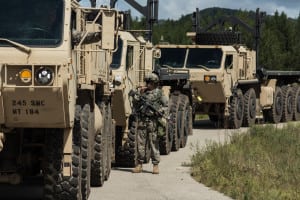COLUMBUS, Ohio – The firms selected for the Army’s Common Tactical Truck (CTT) prototype program are set to deliver their vehicle offerings in early January 2024, a lead official confirmed Wednesday.
“Upon receipt of those prototypes, we will execute some limited testing to improve durability and performance testing with the goal of obtaining the necessary safety certifications to allow the program to move forward with the soldier touchpoints,” Vanessa Pittman, deputy product lead for CTT, told attendees at NDIA’s Tactical Wheeled Vehicles conference here.

Late last month, the Army announced it has selected Oshkosh Defense [OSK], Mack Defense, Navistar Defense and a team of American Rheinmetall Vehicles and GM Defense [GM] to deliver prototypes for its next-generation tactical truck program (Defense Daily, Jan. 30).
The four vendors selected for the effort were awarded $24.3 million in deals and are tasked with delivering prototypes for the following three CTT variants, the Load Handling System (LHS), Off-Road Tractor, and Line Haul Tractor, as well as providing digital designs for the cargo and tanker variants and conducting a design study for a potential wrecker platform.
CTT is intended to replace the Army’s current Family of Heavy Tactical Vehicles (FHTV) truck fleet, currently built by Oshkosh Defense, with new variants that utilize a common chassis and meet roles for the M915 Line Haul Tractor and M1088 Medium Tractor; Palletized Load System (PLS); and Heavy Expanded Mobility Tactical Truck (HEMTT).
The CTT prototyping effort will inform final requirements leading to an updated capabilities development document in FY 25, with aim to move into a full and open competition for production in FY ‘26.
“This is a huge opportunity to modernize the fleet by syncing with industry to evaluate and integrate mature technologies to meet mission requirements, while aligning commerciality and commonality to the maximum extent possible,” Pittman said.
The Army recently concluded its “start work” meetings, Pittman noted, with the firms selected for the CTT prototyping effort, with the next 90 days of the program focused on gathering engineering data on the offerings, coordinating testing plans and moving ahead on a requirement and framing analysis study.
“All the activity we have ongoing now is really just doing the entire engineering finalization, doing all of the industrial sourcing, getting all the parts and then building those vehicles and testing them ourselves to make sure they’re ready to go to the Army,” David Hartzell, president and CEO of Mack Defense, told Defense Daily.
Hartzell noted the Army’s testing with the CTT prototypes will occur at Aberdeen Proving Ground in Maryland.
Following prototype deliveries early next year, Pittman noted the Army will begin the evaluation period, which include “various operational assessments” through soldier touchpoint events.
“The assessments will allow the users the opportunity to provide feedback on how well the prototype performs the same mission roles as our legacy fleet,” Pittman said. “The user feedback and the requirements and framing analysis study will feed into and inform the requirements and the capabilities development document.”